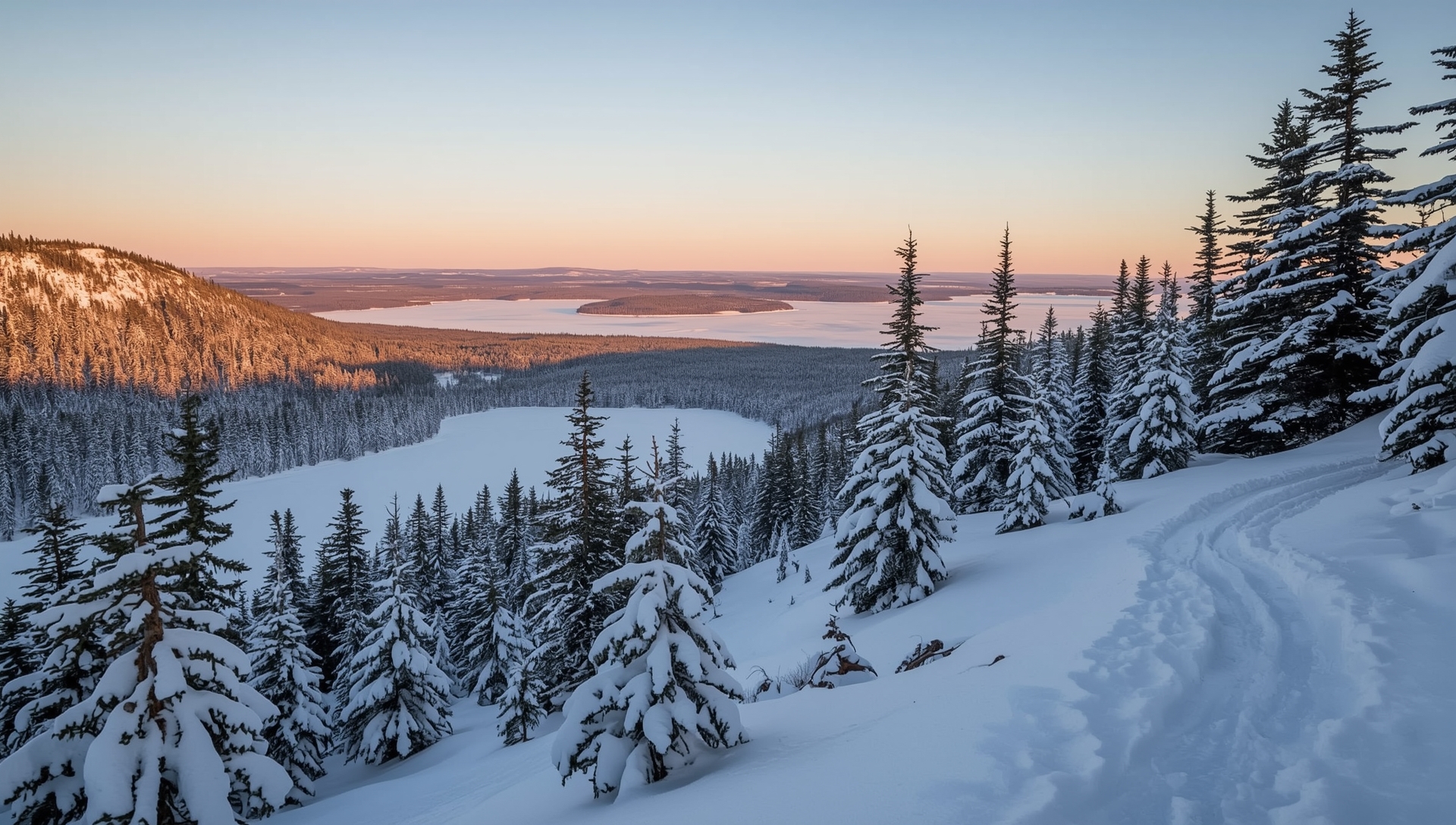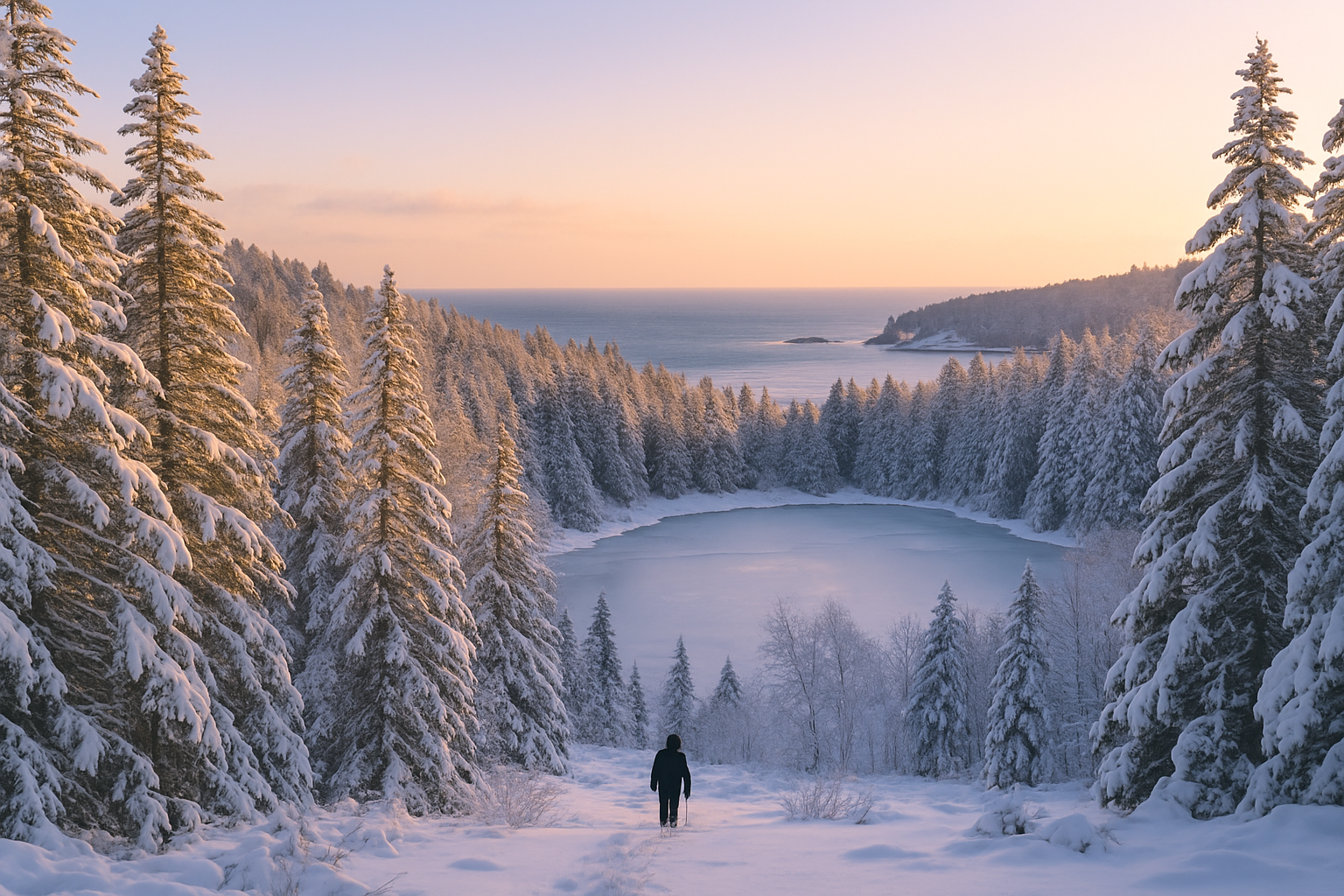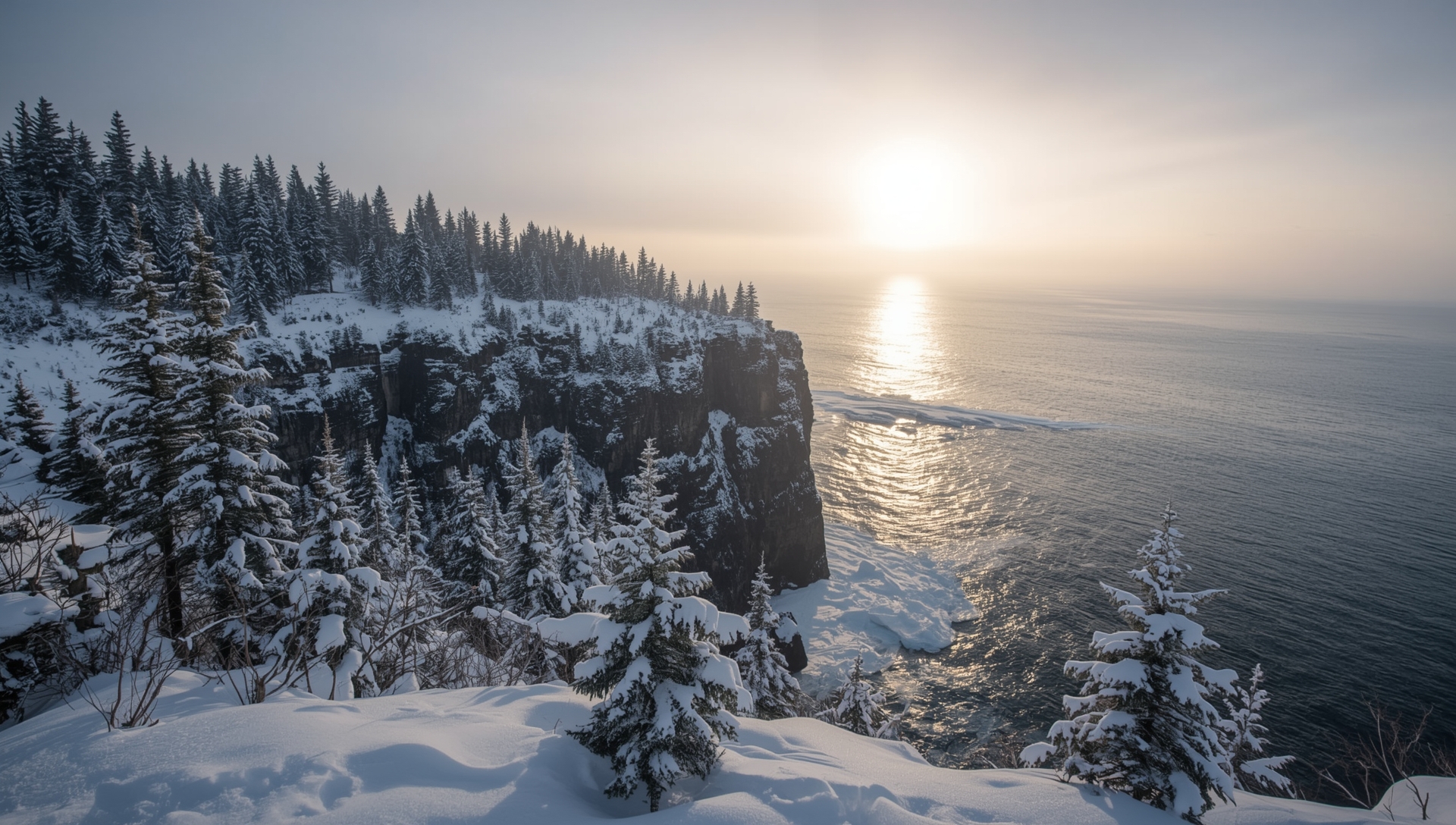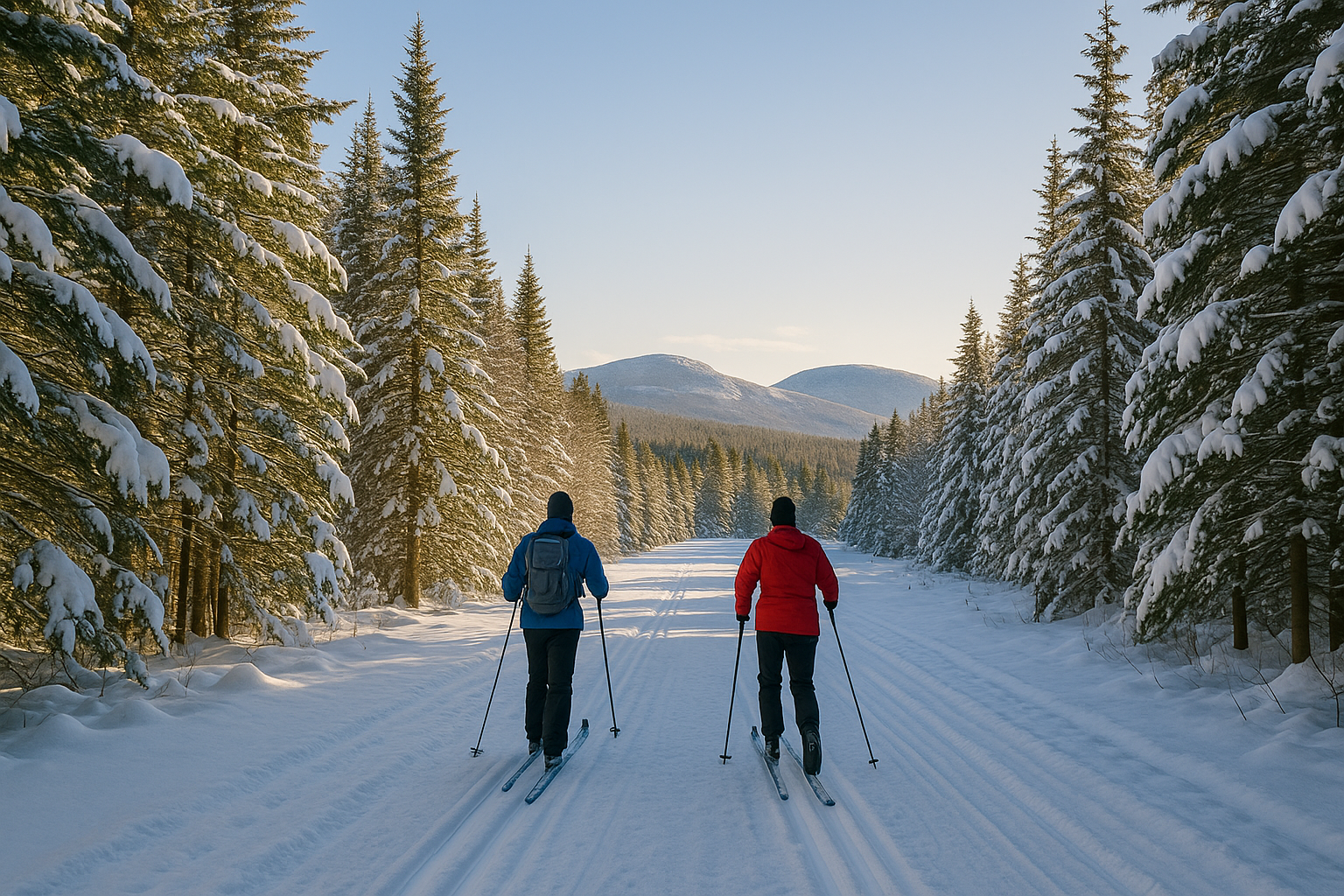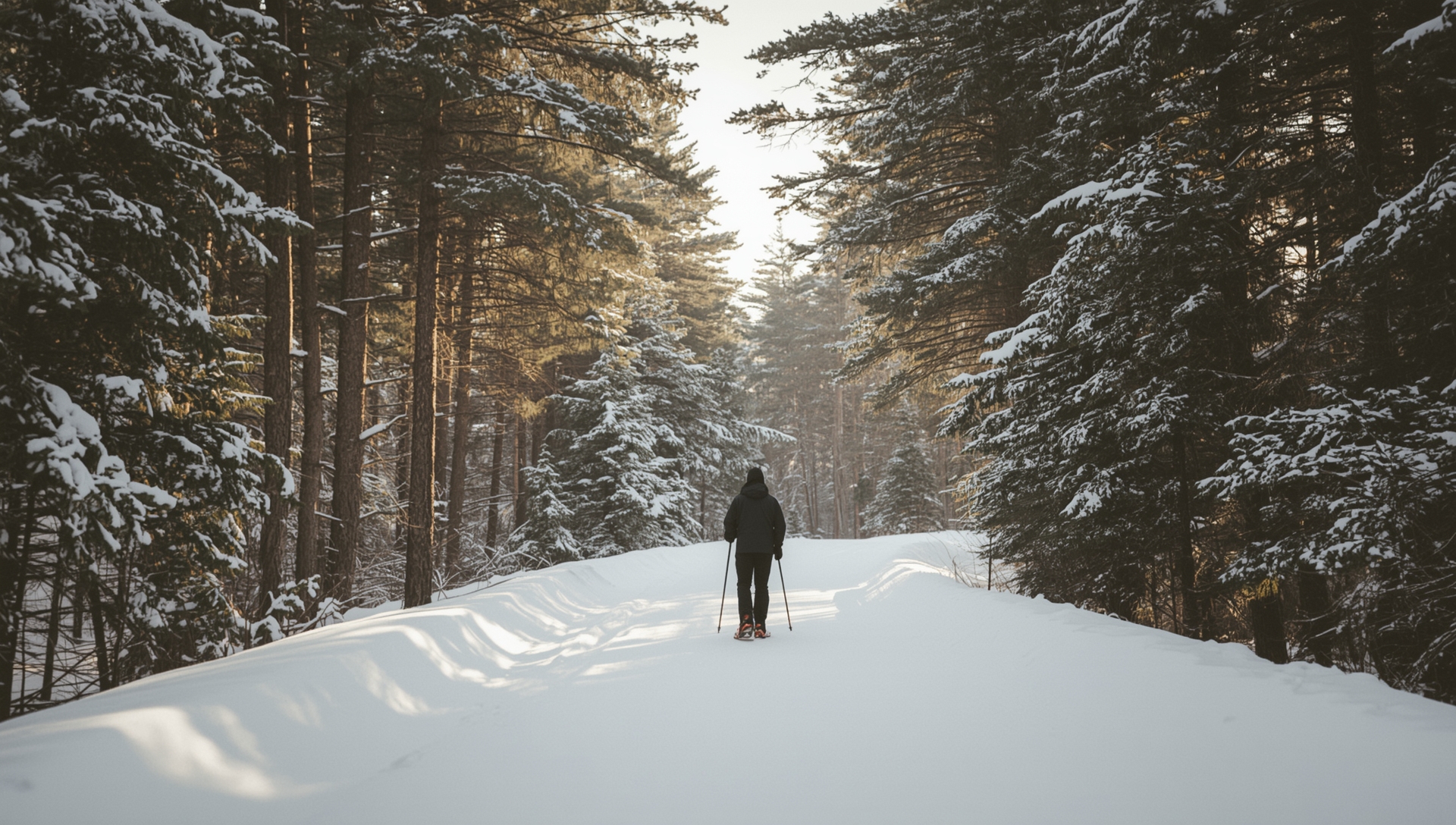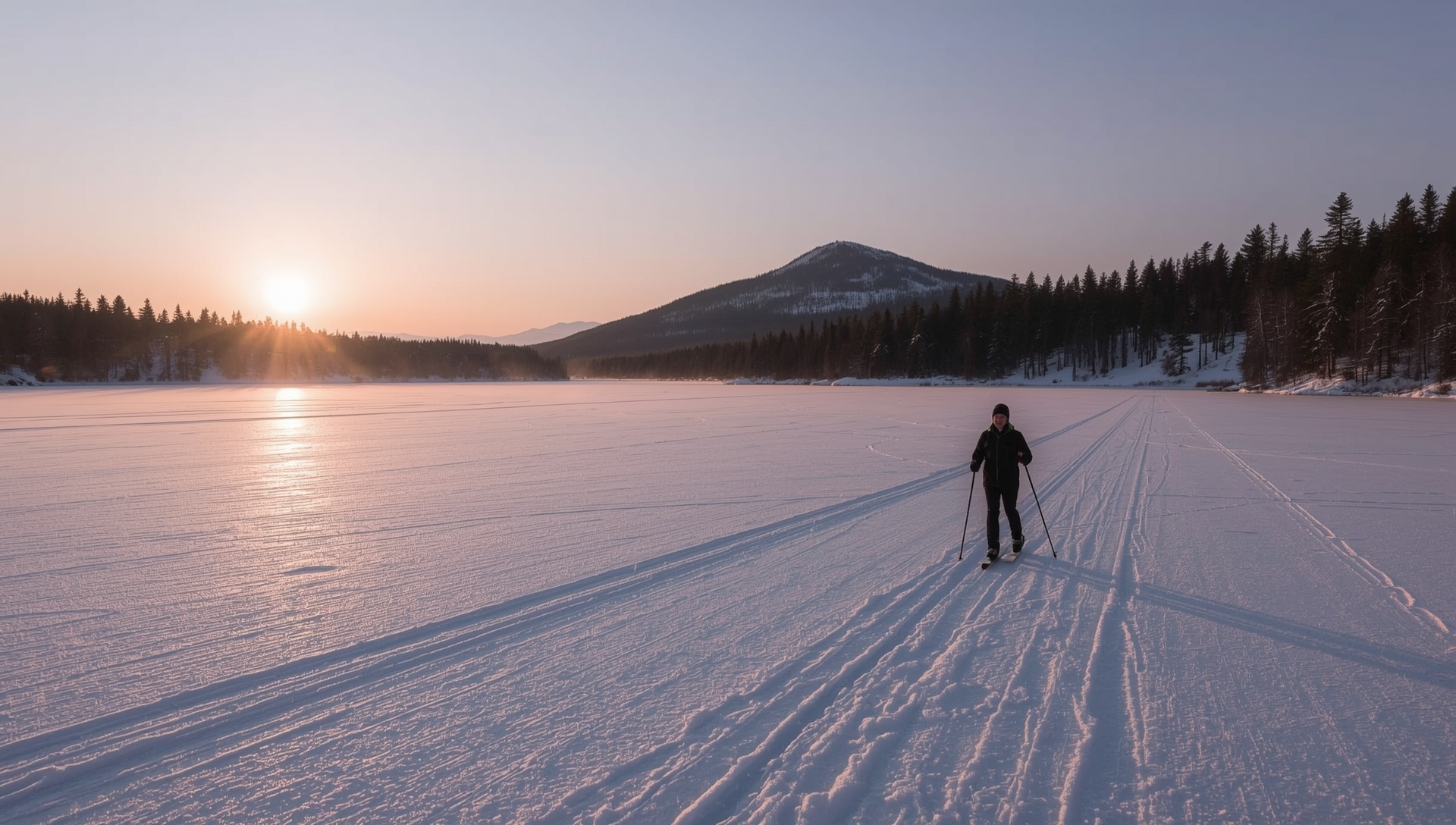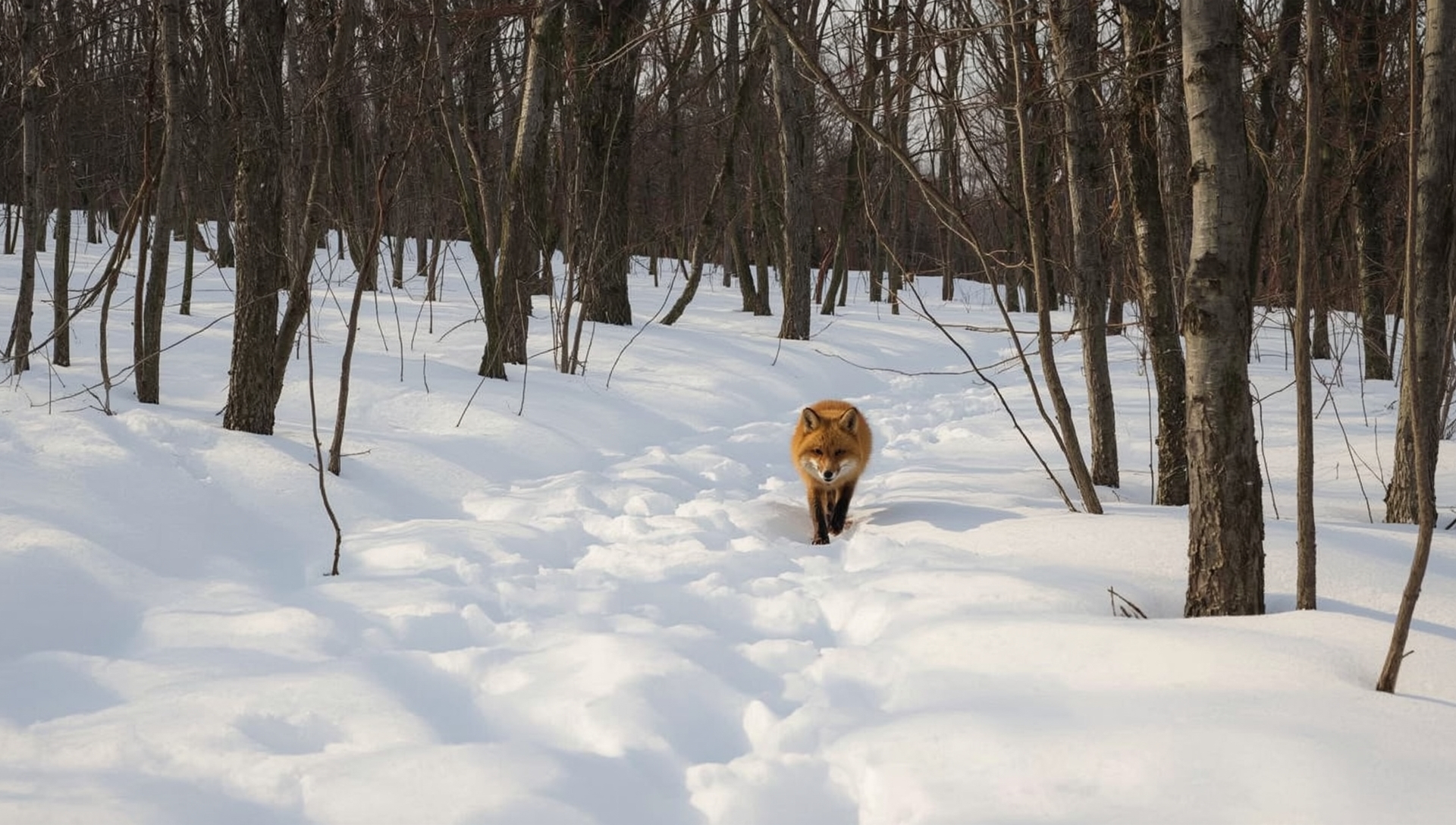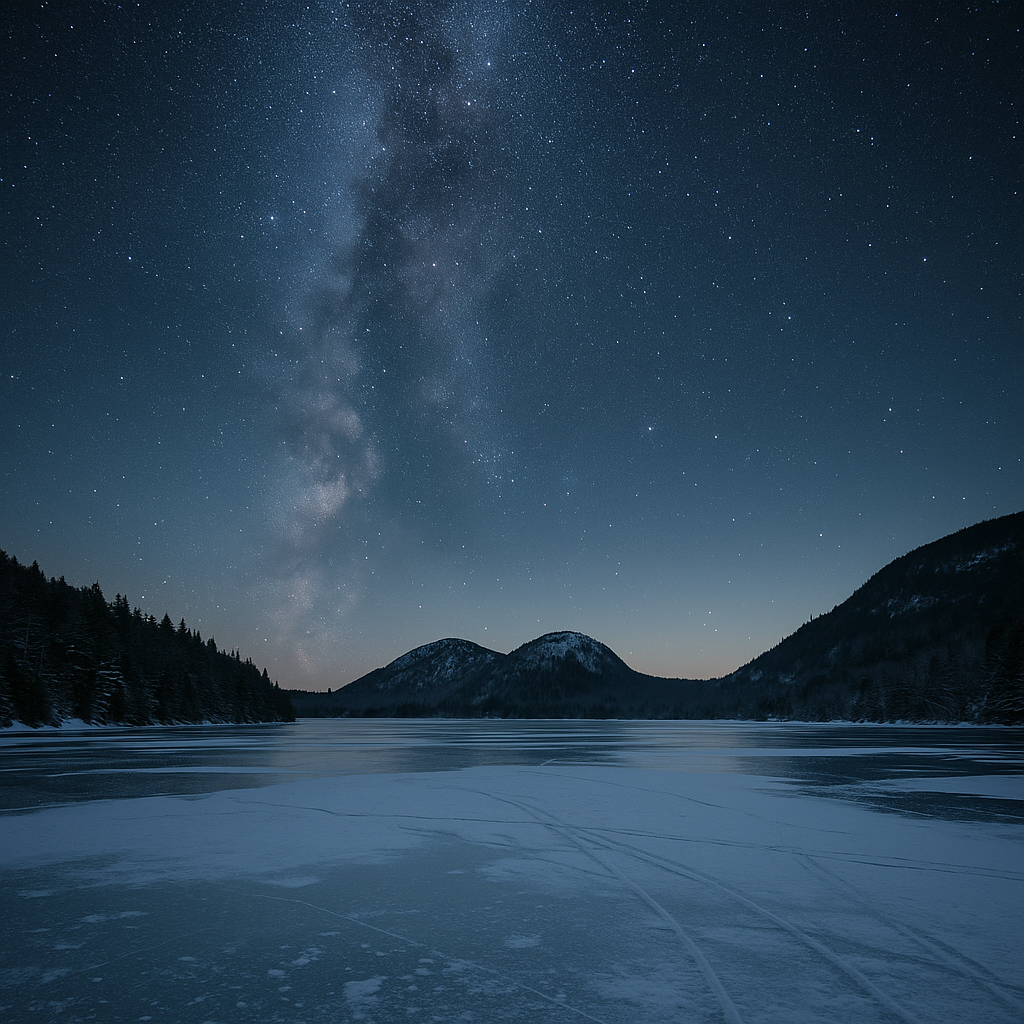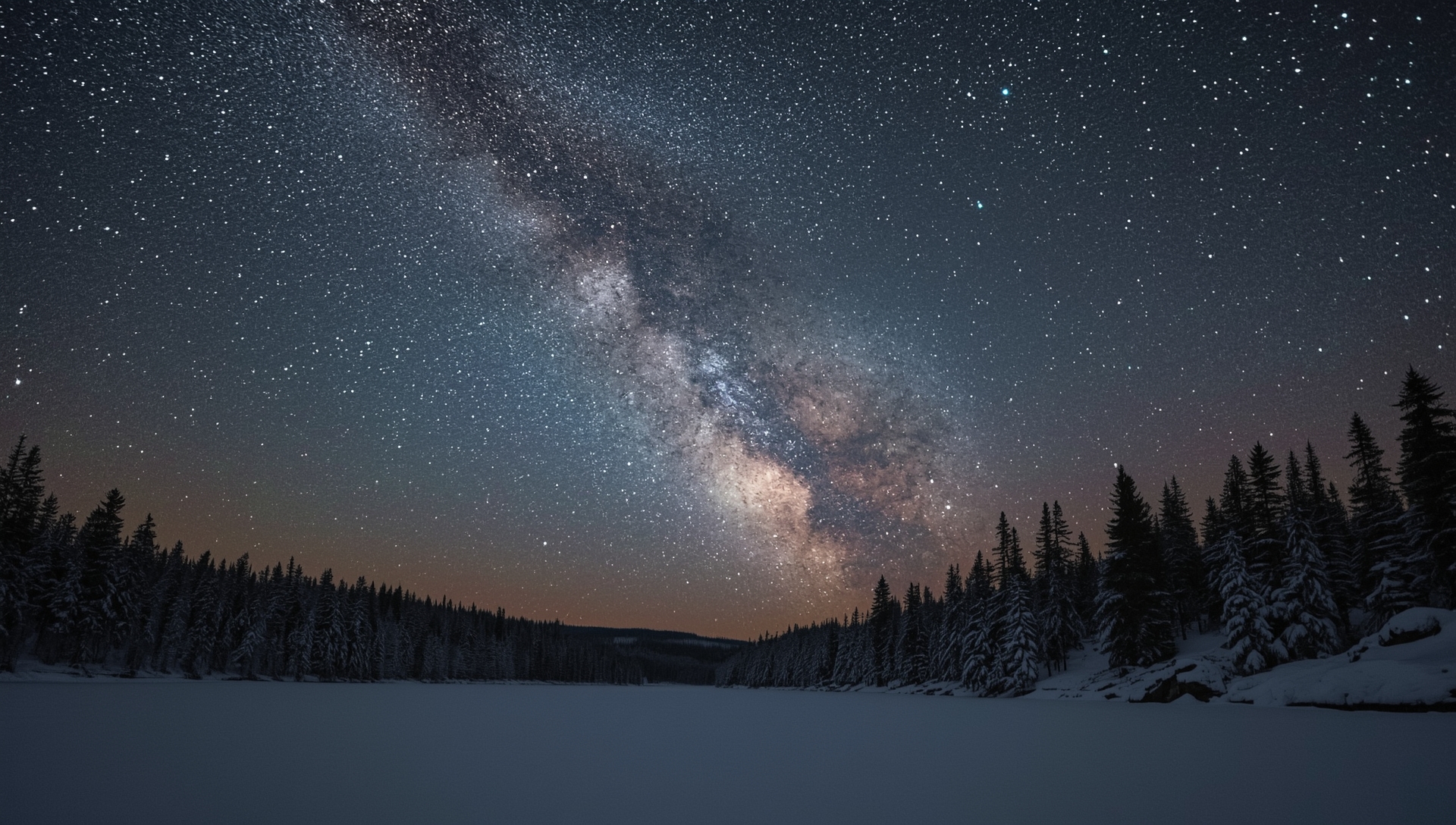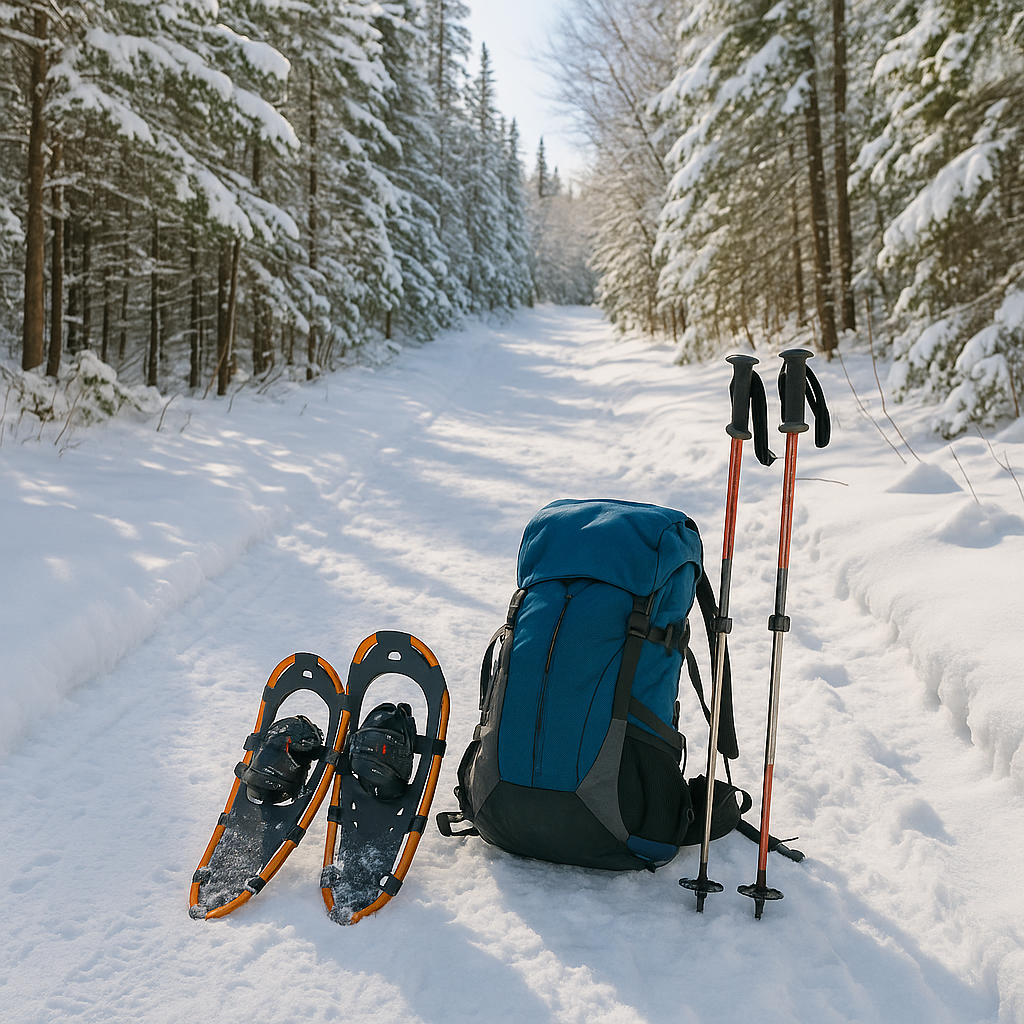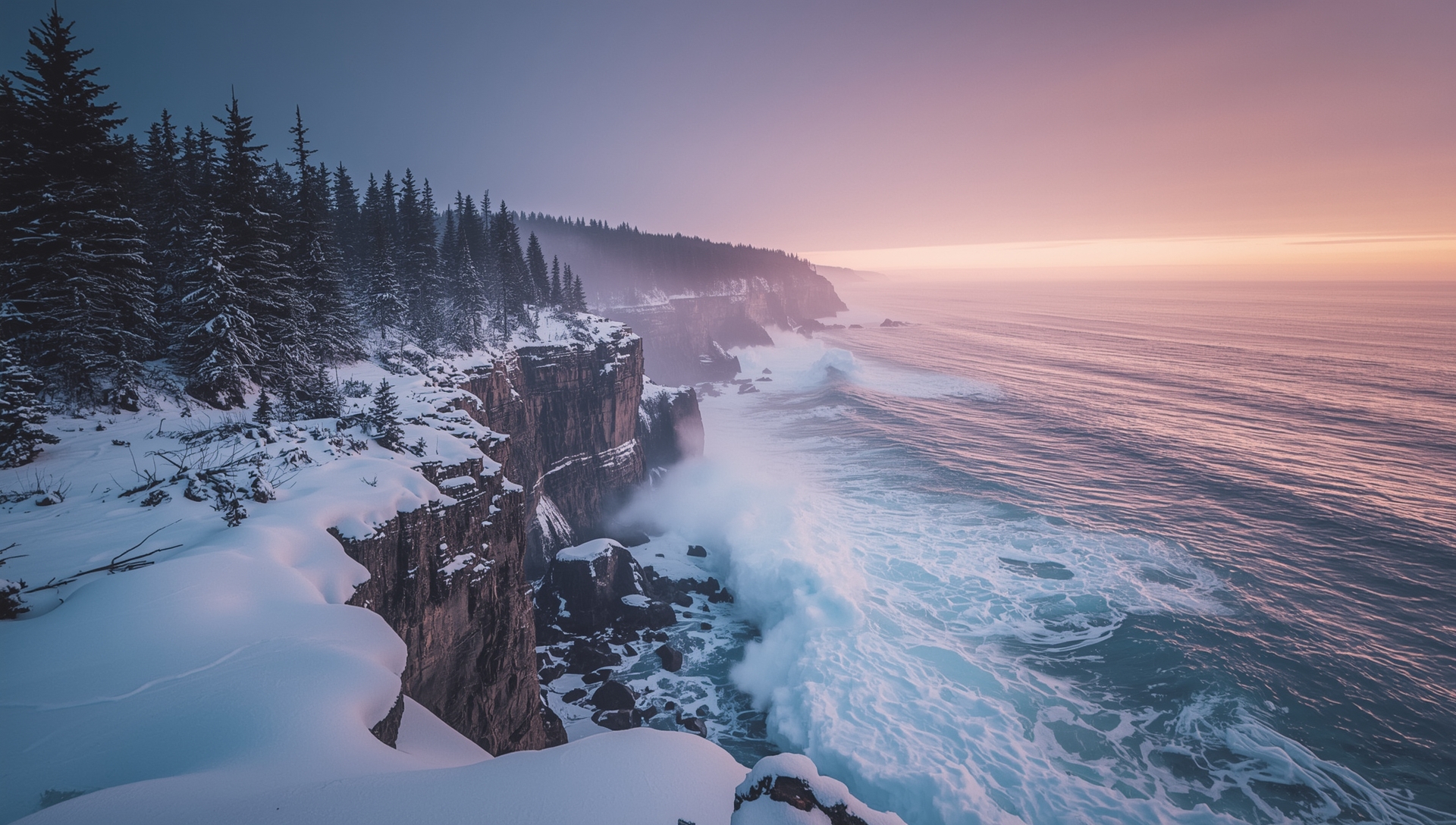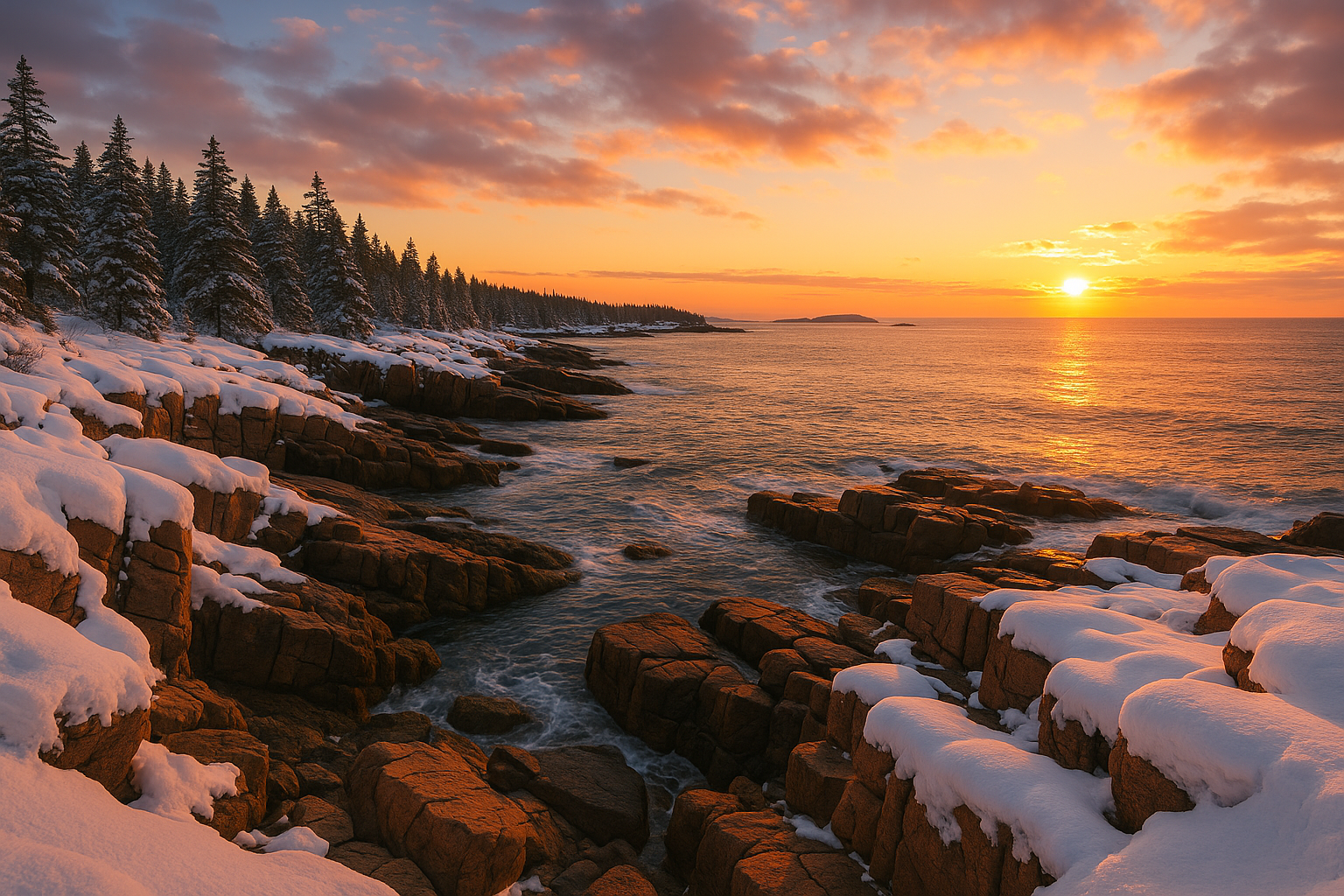Acadia National Park Winter
Discover the Quiet Beauty of Acadia in Winter
When the crowds of summer fade, Acadia National Park in winter becomes a peaceful world of snow, sea, and silence. The air turns crisp and clear, and every sound seems sharper — the crunch of boots on frozen trails, the distant crash of waves on icy granite, the rustle of wind through the evergreens. Bar Harbor slows to a whisper, but for those who make the trip, the reward is an entirely different experience of the park’s soul.
Hiking trails transform into tranquil snowshoe paths, and Cadillac Mountain offers sunrise views that shimmer over snow-covered islands. The Park Loop Road, partially closed to vehicles, becomes a playground for cross-country skiing and winter biking, while Jordan Pond and Eagle Lake freeze into glassy, reflective plains. Photographers chase the delicate pastels of Acadia’s winter sky, while wildlife watchers spot deer and foxes moving gracefully through the snow-draped forest.
It’s a time of stillness and renewal — when nature rests, and visitors rediscover the simplicity of exploration without the rush of summer. Whether you come for solitude, adventure, or a glimpse of the park’s wild heart, winter in Acadia National Park offers an unforgettable kind of magic.
• Snow transforms Acadia National Park into a quiet coastal wilderness
• Cadillac Mountain glows pink and gold at winter sunrise
• Jordan Pond and Eagle Lake freeze into mirror-like plains
• Carriage Roads ideal for snowshoeing and cross-country skiing
• Bar Harbor stays peaceful with cozy winter lodging options
• Ocean Drive and parts of Park Loop Road remain open for scenic drives
• Wildlife sightings include sea ducks, bald eagles, and foxes
• Winter photography captures Acadia’s soft light and frozen coastline
• Visiting Acadia in winter offers solitude and breathtaking natural beauty
Why Visit Acadia During an Acadia National Park Winter?
Most people imagine Acadia National Park in its summer prime — beaches full of sunseekers, trails echoing with the chatter of hikers, and Bar Harbor bustling with open-air cafés and souvenir shops. Yet an Acadia National Park winter reveals another side of this coastal wilderness, one marked by silence, solitude, and raw natural beauty. When the snow begins to fall and the last ferry leaves the harbor, the park becomes something extraordinary — a place where granite cliffs meet frost and wind, and where every footstep across the snow seems to echo into the quiet.
Gone are the crowds and traffic. In their place is stillness — the kind that settles deep into the landscape. Trails and overlooks are often empty, making you feel like you’ve stepped into an earlier, untouched version of Acadia. The soundscape changes too: the rhythmic crunch of boots on snow, the distant caw of a raven, and the steady crash of Atlantic waves freezing mid-spray against the cliffs. Even the air feels sharper, tinged with salt and pine resin, as if freshly distilled from the sea itself.
Snow transforms the familiar into the magical. The pink granite ledges that define Acadia’s summer scenes now shimmer beneath a white glaze, their soft curves highlighted by sunlight reflecting off the snow. Spruce and fir trees bow beneath their icy coats, creating green arches above the paths. Lakes like Jordan Pond, Eagle Lake, and Bubble Pond turn into vast mirrors, their frozen surfaces gleaming under the pale light. Every direction offers something worth pausing for — the swirl of wind-blown snow over a frozen trail, or the sudden appearance of a white-tailed deer moving silently between trees.
Down by the coast, the park shows its wilder side. The Atlantic doesn’t rest in winter. Waves roll in endlessly, breaking with thunder against the cliffs near Thunder Hole and Otter Cliff, coating the rock in ribbons of ice that glitter like glass. At sunrise, Cadillac Mountain glows with hues of pink, lavender, and gold — a sight made even more powerful by the absence of crowds.
An Acadia National Park Winter is a time for reflection, for slowing down and reconnecting with the natural world. It rewards patience and presence, offering beauty to those who venture out into its frozen stillness. Here, the park feels more alive than ever — wild, elemental, and unforgettable.
Best Winter Activities
Winter doesn’t close Acadia National Park — it simply changes the way you explore it. With the crowds gone and the landscape blanketed in snow and ice, the park becomes a playground for quiet adventure. Whether you strap on snowshoes, glide along a frozen trail, or pause to watch winter wildlife by the coast, Acadia in the winter offers a calm beauty that feels worlds apart from summer.
An Acadia National Park winter is about slowing down, noticing details, and embracing the rhythm of the season. You’ll find moments of solitude in places that buzz with activity in July — Jordan Pond, Eagle Lake, and Cadillac Mountain take on a serene, dreamlike quality. The stillness is matched only by the sense of discovery that comes with exploring the park under a layer of snow.
Snowshoeing the Carriage Roads
When winter arrives, Acadia National Park in winter transforms its famous carriage roads into quiet white pathways perfect for snowshoeing. Built by John D. Rockefeller Jr. in the early 1900s, these 45 miles of crushed-stone roads wind gently through forests, lakes, and granite ridges. In Acadia in the winter, they become soft, snow-covered trails where every step crunches beneath your boots and the world feels still.
Snowshoeing offers one of the best ways to explore the park at your own pace. There’s no rush — only the rhythm of breath and snow. The wide roads are easy to follow even after fresh snowfall, making them ideal for both beginners and seasoned adventurers. Locals often say that Acadia Maine winter feels most peaceful when you’re deep in the woods, hearing nothing but the whisper of wind through snow-laden branches.
Popular routes include the loops around Eagle Lake, Witch Hole Pond, and Jordan Pond, each offering sweeping views of frozen water framed by evergreens. On a clear morning, sunlight filters through the trees and sparkles across the snow like scattered glass. These same trails that buzz with cyclists in summer become serene corridors for quiet reflection during Acadia National Park winter.
Bring your own gear or rent snowshoes in Bar Harbor, where outfitters remain open year-round. The nearby Park Loop Road (open in sections even during winter in Acadia National Park) provides access to several carriage road trailheads. Always check conditions before heading out — ice and drifting snow can make some stretches challenging, especially after storms.
Whether you’re exploring alone or with family, snowshoeing captures the essence of Acadia winter — peaceful, beautiful, and completely unhurried. Each step feels like a return to simplicity, surrounded by the quiet grandeur of one of America’s most magical parks.
• 45 miles of snow-covered carriage roads open for winter exploration
• Best routes: Eagle Lake, Witch Hole Pond, and Jordan Pond loops
• Snowshoe rentals available in Bar Harbor for acadia maine winter visitors
• Ideal for beginners — wide, gentle, car-free trails
• Experience pure stillness and beauty during acadia in the winter
• Perfect introduction to Acadia National Park winter activities
Cross-Country Skiing
Gliding through Acadia National Park in winter on cross-country skis is one of the most peaceful and rewarding ways to explore the park’s frozen beauty. When snowfall is deep enough, sections of the carriage roads — those same winding routes designed by John D. Rockefeller Jr. — are groomed by local volunteers, transforming into smooth ribbons of snow that invite exploration. With the crowds of summer long gone, you can ski for miles in near silence, surrounded by frost-tipped spruce and pine.
The loop around Eagle Lake is a favorite among locals and winter visitors alike. On clear days, Cadillac Mountain rises majestically over the glistening white expanse, reflecting soft hues of pink and gold during sunrise. For intermediate skiers, connecting trails near Bubble Pond and Witch Hole Pond offer longer, more varied terrain that reveals the heart of Acadia Maine winter — a world of calm air, soft light, and perfect solitude.
Each glide feels like meditation. The steady rhythm of skis over snow replaces the noise of traffic or footsteps on gravel. Stop for a moment and you’ll hear only the distant echo of waves crashing along the coast, a reminder that even under ice and snow, Acadia remains alive. This balance of quiet forest and wild shoreline defines Acadia in the winter, where skiing becomes more than sport — it’s immersion in the park’s elemental rhythm.
Equipment rentals and trail maps are available in Bar Harbor, which remains partially open through winter in Acadia National Park. Always check snow conditions before heading out, as coastal weather can change quickly. Dress in layers, carry a thermos of something warm, and take your time — you’re not racing anyone here.
Cross-country skiing captures the gentle adventure of Acadia National Park winter activities. It’s freedom, rhythm, and reflection — gliding through Maine’s most beautiful landscape at its quietest and most enchanting.
• Groomed carriage roads near Eagle Lake and Witch Hole Pond in acadia maine winter
• Cadillac Mountain views from open ski sections on clear mornings
• Bring layers and check conditions before skiing Acadia National Park in winter
• Locals maintain popular loops after fresh snowfall
• Peaceful, scenic, and part of the best Acadia National Park winter activities
• Rentals and maps available in Bar Harbor throughout acadia in the winter
Winter Hiking
Hiking through Acadia National Park in winter is a completely different experience from summer — quieter, calmer, and more intimate. The same trails that echo with footsteps and laughter in July fall silent beneath a soft layer of snow. You might not meet another person for miles, only the whisper of wind through frosted pines or the creak of branches shifting under ice. This is acadia in the winter at its most peaceful, where every step feels deliberate and connected to nature’s slower rhythm.
Many of Acadia’s most loved trails remain open year-round, though they take on new personalities when the temperatures drop. Ocean Path, which runs between Sand Beach Acadia and Otter Cliff, becomes a dramatic stage for winter’s power. Waves slam against the rocks, freezing mid-spray into ribbons of ice that glisten in the morning light. On calmer days, the trail feels like a walk through stillness, with endless ocean views and the distant call of gulls.
At Jordan Pond, the snow muffles sound completely. The twin Bubbles rise in the distance, mirrored on the frozen surface below. It’s one of the most beautiful sights in Acadia Maine winter, especially just after sunrise when the light turns the snow pink. For a shorter climb, Great Head Trail offers sweeping views over the icy Atlantic, while Bubble Pond Trail winds through quiet woods that seem untouched by time.
Winter hiking demands preparation — and patience. Ice grips ledges and steeper sections, so microspikes and trekking poles are essential. Dress warmly, carry a thermos, and check weather updates from park rangers before setting out. Even short trails can feel remote in winter in Acadia National Park, and that’s part of the magic.
There’s something deeply rewarding about standing on a quiet overlook, breath steaming in the cold air, looking out across frozen forests and empty coastlines. Acadia national park winter activities like hiking remind you that beauty doesn’t fade with the seasons — it simply changes shape.
• Trails like Ocean Path, Jordan Pond, and Great Head stay open in acadia winter
• Use microspikes — ice often covers cliffs and ledges
• Snow and sunlight create stunning reflections across frozen lakes
• Winter hiking reveals a calmer side of Acadia National Park in winter
• Trail access via Park Loop Road when weather allows
• Experience the solitude of acadia in the winter at its quietest
Wildlife Watching in Acadia National Park Winter
At first glance, Acadia National Park in winter seems silent — the trails empty, the ponds frozen, the woods still. But look a little closer, and you’ll discover the park is very much alive beneath the snow. Acadia in the winter hums with quiet energy, from the rustle of wings overhead to the faint tracks that crisscross the drifts at dawn. Winter strips the park back to its essence, making every wildlife encounter feel more personal, more profound.
Along the rocky shoreline, life continues in motion. Rafts of sea ducks — eiders, scoters, and goldeneyes — ride the rolling waves near Otter Point and Schoodic Peninsula. Their dark feathers contrast beautifully with the whitecaps of the Atlantic. Occasionally, a harbor seal lifts its head through the foam, curious before slipping beneath the icy surface. Loons in their muted gray winter plumage call across the bays, and the cries of bald eagles echo above the frozen trees. These sights and sounds are the heartbeat of acadia maine winter, subtle but unforgettable.
Inland, the snow becomes a living canvas of prints and patterns. You might follow the delicate tracks of a red fox along the carriage roads, or spot the bounding impressions of snowshoe hares, their white coats blending perfectly with their surroundings. Winter in Acadia National Park is also a time when patience pays off — those who wait quietly may glimpse a deer moving silently between the pines or even a snowy owl perched on an open ridge scanning the horizon.
Wildlife watching in Acadia National Park winter is best done slowly, bundled up against the cold with binoculars in hand. The fewer distractions you bring, the more the park reveals. Each moment — the flash of wings, the movement of a shadow — feels amplified in the hush of the season.
Whether standing on a frozen lake or watching waves crash against ice-coated cliffs, the animals of acadia winter remind you that life endures here in every form. Even in its quietest months, this landscape is teeming with resilience and grace — proof that beauty never disappears, it just changes its rhythm.
• Sea ducks, loons, and bald eagles common near the icy coastlines
• Seals rest on frozen rocks around Schoodic and Otter Point
• Inland, look for tracks of red foxes and snowshoe hares
• Occasional snowy owl sightings during acadia national park winter
• Wildlife more visible in snow — perfect for photography
• Discover the life that thrives quietly through acadia in the winter
Scenic Winter Highlights
Winter in Acadia National Park feels like stepping into an entirely different world — a place where silence reigns and familiar trails transform into dreamlike corridors of snow and ice. The air is sharper, the light softer, and even the ocean seems to slow its breath. Gone are the lines of cars and chatter of tourists; in their place are the crunch of snow underfoot and the distant call of a raven echoing through frost-covered pines.
Visiting acadia in the winter means discovering what locals already know: that this park doesn’t close with the season — it simply changes its rhythm. Acadia national park winter activities take on a quieter beauty, from frozen lakes that gleam like mirrors to pink sunrises spilling over Cadillac Mountain. The forest trails, frozen ponds, and granite ridges invite solitude rather than spectacle. Whether you’re exploring with a camera, snowshoes, or simply a sense of wonder, each landmark feels new again beneath its coat of snow. Below are three of Acadia’s most breathtaking winter highlights — places that reveal the park’s wildest and most peaceful side all at once.
Cadillac Mountain
Rising 1,530 feet above the Atlantic, Cadillac Mountain is the heart of Acadia in every season — but in winter, it belongs to those who seek quiet adventure. The Acadia Maine winter weather closes the summit road, turning what was once an easy drive into an invigorating journey of snowshoeing or skiing through forests wrapped in frost. Each step upward feels like leaving the world behind. The scent of spruce drifts on the cold air, the snow crunches rhythmically beneath your boots, and now and then a chickadee flits between branches dusted with ice crystals.
The higher you climb, the wider the view unfolds. Snow-covered boulders mark the ridgeline, and through breaks in the trees, Frenchman Bay glitters far below. Reaching the summit of Cadillac in winter is less about conquering height than embracing solitude. There’s a moment — when you step into the open and see the Porcupine Islands scattered like white pearls across the bay — that the cold and effort vanish into awe.
At sunrise, Cadillac becomes one of the first places in America to greet the sun. In winter in Acadia National Park, the low light paints the snow in shades of rose, gold, and violet. The Atlantic gleams like liquid metal beneath the horizon, and wind carves patterns through the snowdrifts that catch the first rays of morning. Standing here, with the world silent and the sea stretched endlessly before you, you understand why locals call it sacred ground. Acadia national park winter at its finest — pure, luminous, and completely unhurried.
Jordan Pond
In summer, Jordan Pond is famous for its perfect reflections and bustling shoreline café. But during Acadia National Park in winter, the scene transforms into something serene and poetic. The pond freezes into a broad silver plain framed by snow-laden evergreens and the rounded peaks of the Bubbles. Early in the morning, mist hovers above the ice like breath, catching the first light as it filters through bare branches.
The loop trail that circles the pond remains open, and with microspikes or snowshoes, it offers one of the most tranquil walks in acadia in winter. The stillness is so complete that even small sounds — the creak of ice expanding, the whisper of a crow’s wings overhead — seem magnified. Every turn of the path opens a new perspective: icicles hanging from shoreline rocks, snowdrifts sculpted by wind, and glimpses of the Bubbles mirrored faintly on the frozen surface.
This is one of the best Acadia National Park winter activities for those who love peace and photography. On sunny days, the pond reflects a sky of brilliant blue; on overcast afternoons, it becomes a canvas of muted silver and pearl. Few visitors reach it in winter, so you may find yourself completely alone with the quiet. That solitude is the essence of winter in Acadia National Park — not emptiness, but calm abundance. Pause halfway around the pond, breathe the sharp, clean air, and you’ll feel the entire landscape hum softly with life beneath the snow.
Schoodic Peninsula
If you want to see the untamed spirit of Acadia National Park winter, head to the Schoodic Peninsula, the park’s only section on the mainland. Even in summer, it feels remote; in winter, it borders on the mythical. The six-mile Schoodic Loop Road winds along the edge of the Atlantic, where waves hurl themselves against granite cliffs and freeze mid-crash into sculpted forms of ice. The sound of the surf echoes off the rocks like distant thunder, and when the temperature drops low enough, the spray turns the ledges into glassy mosaics that shimmer in the sun.
This is acadia maine winter in its rawest form — a place of roaring seas and still horizons. On stormy days, snow drives sideways across the peninsula, wrapping the spruce trees in white shawls. When the skies clear, the ocean glows cobalt against the snowfields, and seabirds — eiders, gulls, and loons in their winter plumage — circle the rocky coves. You can stop at pullouts along the road to take in panoramic views of Mount Desert Island dusted with snow across the bay.
The solitude here is absolute. Few visitors brave the cold, and those who do often have the landscape to themselves. It’s one of the best spots for acadia winter photography, where contrast and light seem made for the lens. Whether you linger to watch the shifting ice or walk the shoreline trails, Schoodic reminds you that acadia in the winter months isn’t only about peace — it’s about power. The Atlantic’s rhythm doesn’t rest, but it slows just enough for you to feel part of it.
• Cadillac Mountain is one of the first places in the U.S. to see sunrise — even in the heart of Acadia National Park Winter.
• Jordan Pond reaches depths near 150 feet, and during Acadia Maine winter, its ice can take weeks to fully form.
• The Schoodic Peninsula is the only part of Acadia National Park located on the mainland — ideal for peaceful acadia in winter drives.
• Winter’s crystal-clear air often makes distant islands and ridges appear closer than they do in summer.
Quick Tips:
• Bring traction gear like microspikes — icy trails are common on popular winter in Acadia National Park hikes.
• Check for road and summit closures before driving Park Loop Road or attempting Cadillac Mountain routes.
• Dress in layers — sea wind can make Acadia in the winter months feel colder than the temperature shows.
• Pack a thermos and snacks — many Bar Harbor cafés and lodges close during the off-season.
Winter in Bar Harbor
While Bar Harbor slows down in winter, it doesn’t sleep — it simply exhales. The bustle of summer gives way to a calmer rhythm, and the town takes on a quieter charm that’s every bit as magical. The same streets that buzz with visitors in July are now dusted with snow, their lamps casting a golden glow on the sidewalks. The harbor rests under a thin veil of ice, fishing boats bobbing gently in the cold Atlantic, and the cries of gulls echo through the crisp morning air. It’s a world transformed — peaceful, reflective, and full of small delights for those who come seeking them.
Winter in Bar Harbor is defined by warmth of a different kind. Inside, fires crackle in old brick hearths, and locals gather over mugs of coffee or bowls of chowder. The town’s smaller number of open inns, pubs, and cafés become cozy refuges from the chill — intimate, welcoming, and authentic. After a day exploring Acadia National Park Winter trails, there’s nothing better than walking into a spot like the Thirsty Whale Tavern or Galyn’s, unzipping your jacket, and feeling the heat of a wood stove on your hands. Lobster stew, clam chowder, and wild blueberry pie taste richer in winter, the kind of comfort food that perfectly matches the coastal cold.
Unlike the fast pace of summer, acadia maine winter in Bar Harbor moves slowly and softly. Locals have more time to talk, share stories, and recommend their favorite quiet corners — perhaps a snowy walk along the Shore Path, or the best viewpoint to watch seals playing near the pier. The crowds are gone, but what remains is connection: a town that feels less like a destination and more like a community you’ve been invited into.
For a small coastal town, Bar Harbor still knows how to celebrate the season. Some years bring the Acadia Winter Festival, which adds a spark of festivity with guided hikes, art workshops, photography sessions, and stargazing events. Even without a festival, you’ll find beauty in the simple pleasures — holiday lights reflecting on the harbor, a morning stroll past snow-covered cottages, or sipping hot chocolate while snow drifts outside a café window.
Bar Harbor in acadia in the winter is less about sightseeing and more about slowing down. It’s a time to rest, reflect, and rediscover what makes Maine’s coast so special. The pace is gentle, the air is clear, and the sense of peace runs deep — a perfect companion to the quiet majesty of winter in Acadia National Park.
 Golden light spills from shop windows as snow falls softly over Bar Harbor’s peaceful winter streets
Golden light spills from shop windows as snow falls softly over Bar Harbor’s peaceful winter streets- Temps: 15–35°F (–9–1°C) — colder with coastal wind.
- Season: Snow from Dec–Mar, sometimes early Nov–Apr.
- Access: Park Loop Road mostly closed; Sand Beach & Thunder Hole open when clear.
- Cadillac Summit: vehicle road closed; foot, ski & snowshoe access only.
- Top winter activities: snowshoeing, cross-country skiing, hiking, wildlife watching.
- Gear: microspikes, waterproof boots, warm layers, hat & gloves.
- Bar Harbor: limited lodging / cafés in acadia in the winter — book ahead.
- Fees: entrance often waived Dec–Apr; confirm at NPS Acadia.
Stargazing & Night Experiences
One of the quietest — and most extraordinary — gifts of an Acadia National Park Winter is its night sky. With daylight fading early, the evenings stretch long and dark, unveiling a canopy of stars that feels almost infinite. The crisp, dry air of acadia in winter acts like a lens, sharpening the constellations and revealing stars that summer’s humidity often hides. Each breath feels sharper, each sparkle clearer, and each moment under that vast black sky somehow slower — as if time itself respects the silence of the park.
When the crowds of summer vanish, Acadia transforms into one of the best stargazing destinations in New England. With minimal light pollution and clear northern air, the sky becomes an endless stage. Orion strides across the horizon, the Big Dipper points the way north, and the Milky Way spills like powdered glass over the forested ridges and frozen ponds. For many who visit winter in Acadia National Park, the magic happens not just during the day, but long after the sun sinks below the horizon.
Some of the most beautiful viewing spots are familiar daytime landmarks reborn in moonlight. At Jordan Pond, the frozen surface acts like a mirror, reflecting the stars above in eerie perfection. The twin peaks of the Bubbles stand like dark sentinels on the horizon, their shapes framed by constellations. In the distance, the faint crunch of snow might be the sound of a fox or owl — reminders that life here continues, quietly and unseen.
On the Schoodic Peninsula, the experience feels even wilder. With its open Atlantic horizon, the stars rise and set with dramatic clarity. The waves roll in with rhythmic crashes, and when the moonlight catches the spray, it glitters like stardust. Here, under the vast winter sky, you might see the Milky Way arching from one edge of the sea to the other. And, on rare nights when the air is electric and cold, the aurora borealis dances above the ocean — ribbons of green and pink rippling in silence, an unannounced gift of acadia maine winter.
For photographers, these long nights are pure gold. Snow reflects faint starlight, giving definition to the landscape even without the moon. Whether capturing time-lapse sequences of star trails or single exposures of the Milky Way above the Acadia National Park winter ridgelines, the park offers endless possibilities for those willing to brave the cold. For others, the joy lies simply in standing still — feeling the crunch of snow beneath their boots, watching their breath rise into the starlit air, and realizing how impossibly vast and beautiful the world really is.
Winter in Acadia isn’t silent at all — it hums softly, like the faint pulse of a sleeping world. Beneath that sky, it’s easy to feel small, but in the best possible way — part of something larger, brighter, and endlessly timeless.
- Best spots: Jordan Pond (frozen reflections), Schoodic Peninsula (open ocean horizon), Seawall for low light.
- Timing: Long nights in Acadia National Park winter mean prime viewing 7–11pm; check moon phase for Milky Way visibility.
- Weather: Cold, dry air during acadia maine winter gives the sharpest stars; avoid hazy or windy nights.
- Safety: Pack microspikes and a headlamp with red light; trails ice over quickly in the winter in Acadia National Park.
- Camera basics: Manual focus, wide lens, ISO 1600–3200, f/2–f/2.8, 10–20s exposures; use a sturdy tripod.
- Warmth: Layer up, hand warmers, thermos; batteries drain fast in acadia in the winter months—keep spares warm.
- Etiquette: Minimize white lights; use red mode to protect night vision for you and others.
- Bonus: Watch Kp index for aurora chances; clear, cold nights in acadia in winter can surprise you.
Travel Tips for Acadia in Winter
Visiting Acadia National Park Winter takes more planning than a summer trip, but that’s part of its magic. When snow settles on the granite cliffs and the crowds disappear, you discover a version of Acadia that feels personal and unspoiled. With the right preparation, you’ll experience quiet trails, frozen ponds, and coastal views framed by ice — all without the noise of high season. The park rewards visitors who come prepared, ready to embrace both its beauty and its challenges.
- Plan Your Stay Early
Bar Harbor and nearby towns slow down during winter, but they don’t shut down completely. Only a handful of inns, lodges, and Airbnbs remain open year-round, and those cozy retreats — especially ones with fireplaces or ocean views — can fill quickly during holidays or long weekends. Book early if you’re visiting between December and February, and confirm whether your lodging includes winter access to parking and heating options. Staying in town keeps you close to amenities, while cabins and chalets on Mount Desert Island offer the serenity that defines Acadia in the winter.
- Pack for True Winter Conditions
Temperatures typically range from 15–35°F (–9 to 1°C), with coastal wind chills making it feel much colder. Waterproof boots, insulated gloves, a thermal base layer, and a windproof shell are essential. Snowstorms can roll in quickly along the coast, so bring extra layers and dry socks. A compact thermos filled with something warm can be a simple luxury when hiking in cold air. Remember: Acadia Maine winter weather is unpredictable — clear mornings can turn snowy by afternoon.
- Gear and Navigation
Unlike summer, rental options for snowshoes, skis, or traction gear are limited. Bring your own equipment, especially if you plan to explore the carriage roads or tackle winter hiking trails. Microspikes or crampons make a huge difference on icy surfaces, and trekking poles help with balance. Always download offline maps or carry a printed NPS map; cell service can fade in the park’s valleys and forests. GPS apps don’t always show seasonal closures, so rely on official park information before setting out.
- Know What’s Open
Most of Park Loop Road is closed to vehicles during winter in Acadia National Park, though the Ocean Drive section near Sand Beach and Thunder Hole sometimes opens when conditions allow. Cadillac Mountain’s summit road remains closed to cars until spring — reaching the top requires snowshoes, skis, or determined hiking. Facilities like restrooms and visitor centers operate on limited hours, so plan accordingly.
- Smart Supplies and Safety
Many Bar Harbor shops and restaurants close for the season, so stock up on groceries, snacks, and bottled water before you arrive. Always carry an emergency kit in your vehicle — include blankets, water, non-perishable food, and a flashlight. Keep gas tanks above half full, since rural stations can close early in winter. Photography enthusiasts should store spare batteries inside their jacket; cold drains power fast.
With the right mindset, Acadia National Park Winter isn’t about enduring the cold — it’s about embracing the peace that comes with it. Preparation turns potential hardship into quiet joy: a sunrise hike with no one else in sight, a picnic by a frozen pond, or the sound of waves breaking against icy granite. With thoughtful planning, you’ll find that Acadia’s wild winter landscape is not a challenge — it’s a reward.
- Lodging: Reserve early — limited inns and cabins stay open in acadia in the winter.
- Clothing: Thermal base layers, waterproof boots, insulated gloves, hat, and windproof shell.
- Gear: Bring snowshoes, skis, and microspikes — rentals are scarce during acadia maine winter.
- Navigation: Download offline maps or carry paper maps; GPS may not reflect closures.
- Access: Park Loop Road mostly closed; Sand Beach and Thunder Hole open weather-permitting.
- Safety: Keep blankets, snacks, and a flashlight in your car — storms can move fast in winter in Acadia National Park.
- Supplies: Stock up on groceries and fuel before arrival; Bar Harbor operates on limited hours.
- Photography: Spare batteries lose charge in cold — store them close to your body for warmth.
- Bonus Tip: Start hikes early — daylight is short in Acadia National Park winter months.
Wrapping Up
Acadia National Park Winter is the park at its most serene — a time when silence speaks louder than sound and the landscape feels reborn under snow and ice. Trails that bustled with summer hikers now lie hushed beneath white canopies, each footstep a soft imprint in powder. The familiar becomes new again: granite cliffs shimmer with frost, spruce forests glisten after snow, and frozen ponds mirror pale skies that shift between silver and blue. The Atlantic still roars, crashing against icy ledges with breathtaking power, a reminder that even in stillness, Acadia never truly rests.
Winter changes not only the scenery but the way you move through it. You walk slower, breathe deeper, and notice more — the flicker of a red fox across a trail, the whisper of snow falling from a branch, the play of light as the sun dips early behind the mountains. For snowshoers and skiers, the acadia maine winter landscape becomes a quiet playground; for photographers, it’s a season of pure clarity, where every color and shadow stands out in sharp relief.
Yet, perhaps the greatest gift of winter in Acadia National Park is the stillness itself — a peace rarely found in modern life. Here, you can stand alone on a cliff above the frozen sea and feel the rhythm of nature slow to meet your own. Come prepared, bring curiosity, and let Acadia in the winter reveal its quiet beauty. It’s not just another season — it’s a transformation that stays with you long after the snow melts.
What makes Acadia National Park in winter worth visiting?
Visiting Acadia National Park in winter is like stepping into a different world — snow-covered cliffs, frozen lakes, and quiet forest trails. Unlike summer, the crowds disappear, leaving you to explore the peaceful side of acadia in the winter months.
Can you hike or snowshoe in acadia in the winter?
Yes! Snowshoeing and hiking are two of the most popular acadia winter activities. Carriage roads and trails around Eagle Lake and Jordan Pond are ideal for exploring Acadia National Park winter landscapes blanketed in snow.
What is the weather like during acadia maine winter?
Expect cold, crisp air and regular snowfall, with daytime highs around 25°F to 35°F. The weather makes for breathtaking scenery — especially at sunrise on Cadillac Mountain or along the icy shores during winter in Acadia National Park.
Is Park Loop Road open during acadia winter?
Most of the Park Loop Road closes in winter, but Ocean Drive remains open for scenic drives. It’s a perfect way to take in coastal views, frozen waves, and snow-dusted cliffs while experiencing Acadia National Park winter beauty safely.
What wildlife can you see in Acadia National Park winter season?
Even during acadia maine winter, the park stays full of life. Watch for sea ducks, loons, and eagles near the shore, and fox tracks or snowshoe hares inland. Wildlife watching is one of the quiet highlights of winter in Acadia National Park.
Back to Best Time to Visit Acadia
Want insider tips for Acadia and beyond? Join our free newsletter and get seasonal park updates, planning advice, and hidden gems delivered straight to your inbox.
Sign Up
